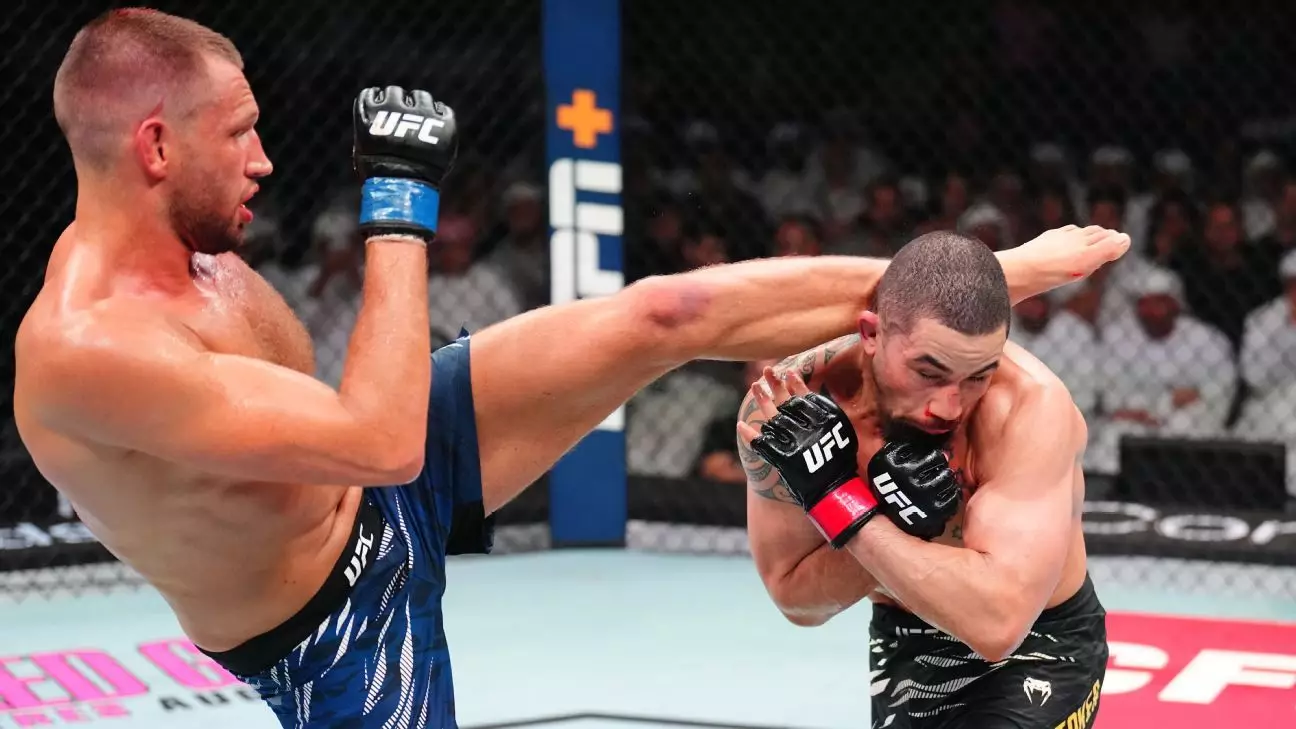Reinier de Ridder’s recent UFC performance signifies more than just a win; it marks the ascendance of a resilient and strategic fighter eager to stake his claim at the top. Facing off against the storied Robert Whittaker, de Ridder demonstrated not only skill but relentless tenacity. His victory by split decision, in a fight that many expected him to dominate more conspicuously, reveals a fighter whose true strength lies in adaptability and mental toughness rather than raw knockout power alone.
Despite the judges’ decision being razor-thin, the statistical disparity between de Ridder and Whittaker profoundly underscores his dominance. Landing 169 strikes compared to Whittaker’s 100, and maintaining significant control in both standing and ground exchanges, de Ridder proved that volume and pressure can threaten even the most seasoned opponents. What’s striking is how he prioritized a tactically aggressive approach, constantly pressing forward, which ultimately sapped Whittaker’s defenses and resilience.
This fight examined the myth that grappling specialists rely solely on submissions or takedowns; instead, de Ridder’s calculated pressure and volume stand as testament to a versatile fighter willing to adapt his game plan to overwhelm opponents. His aspirations for a title shot gained clarity after this victory—a statement asserting that he belongs among the division’s elite, not just as a grappler, but as a well-rounded threat capable of forcing decisions.
Beyond the Numbers: The Heart and Strategy of a Rising Star
While stats tell part of the story, de Ridder’s mental fortitude shined through in critical moments. His survival after Whittaker’s rally in the third round, where the former champion nearly finished him with ground strikes, exemplifies resilience. Such moments showcase that fighting is as much about mental toughness as physical ability. De Ridder absorbed significant damage yet persisted, demonstrating a capacity to stay composed under pressure—a trait that separates good fighters from great.
His background as a grappler, with 14 submission wins, often risks stereotyping him as a one-dimensional artist. However, the fight against Whittaker — which he chose to approach with relentless volume and controlled aggression rather than solely relying on his submission skills — highlights his evolution. His willingness to engage in dangerous exchanges displays confidence in his striking and his capacity to adapt mid-fight, qualities that make him a more unpredictable and formidable opponent.
This year has been pivotal for de Ridder’s growth—submitting Kevin Holland, knocking out Bo Nickal—and now, defeating a top-five ranked contender. It indicates a fighter embracing the challenge of the UFC’s highest level with a fearless attitude and a desire to prove himself against the best. His training environment at Kill Cliff FC in Florida provides the right blend of technical discipline and high-level preparation necessary for such a rapid ascent.
The Future of the Middleweight Divison and De Ridder’s Bold Ambitions
De Ridder’s callout of the division’s top contenders underscores his unwavering confidence. His desire to face either Khamzat Chimaev or Dricus Du Plessis illustrates a fighter willing to embrace the toughest challenges, seeking to cement his place among the division’s elite. He recognizes that to truly establish himself, he must test his skills against the highest-ranked athletes, and his willingness to step into that arena should be admired.
For Whittaker, the loss marks a turning point, as it’s the first time since 2013 he’s faced back-to-back defeats. Though at 34, his resilience remains admirable, but this setback serves as a stark reminder that even the greatest need to adapt and evolve. Meanwhile, de Ridder’s performance signals a shift in the division—a new force rising, unafraid to challenge established stars and redefine perceptions of what a middleweight contender can be.
In essence, Reinier de Ridder’s victory is more than a single fight—it symbolizes a paradigm shift in the UFC middleweight division. From a backgrounds rooted in submission mastery to an aggressive, dynamic fighting style, he exemplifies the modern warrior—versatile, hungry, and unapologetically ambitious. Whether he can translate this momentum into a title reign remains to be seen, but there’s no denying that he has already begun rewriting the narrative of who belongs at the top.


Leave a Reply